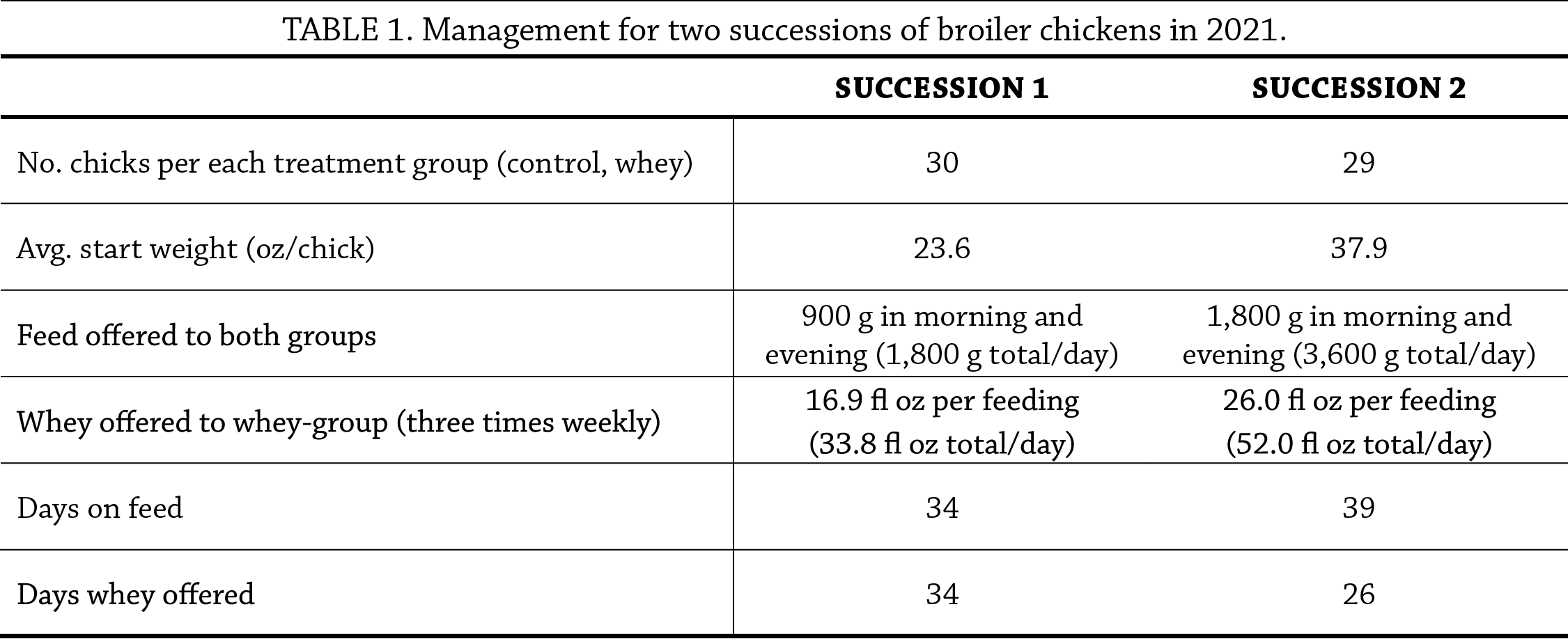This research was funded by the McKnight Foundation.
In a Nutshell:
- Whey is a common byproduct of making dairy products from goats raised on the farm by Carmen & Maja Black, Helaina Thompson and Carlos Williams.
- They wondered if the whey produced on the farm could improve broiler chicken growth when offered as a supplement to the chickens’ feed.
Key Findings:
- Offering whey with feed did not improve chicken carcass weights compared to chickens that were not offered whey. In one succession, carcass weights were reduced from offering whey.
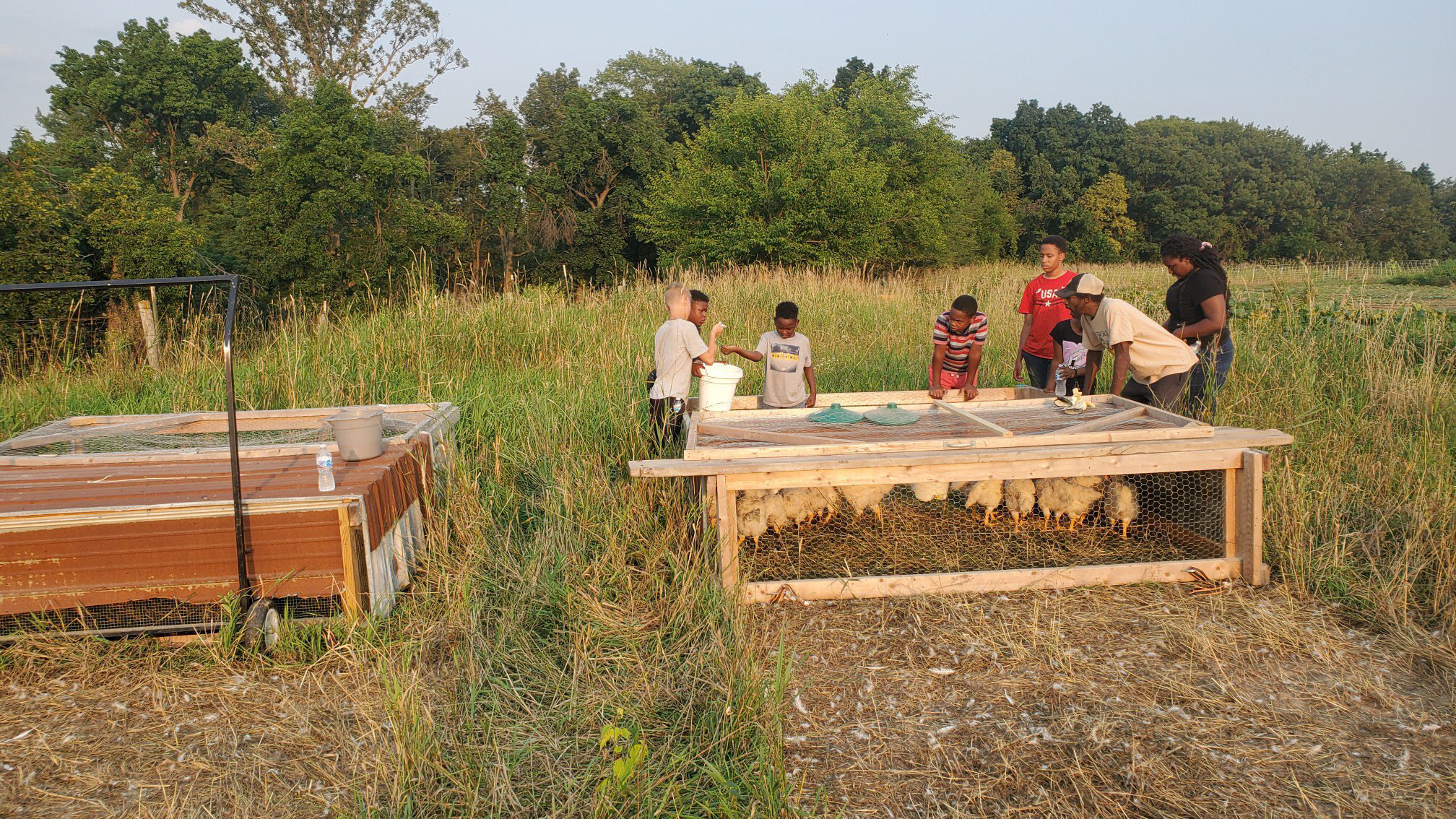
Carlos Williams (ball cap), and several helpers at Sundog Farm, tend to the broilers raised in chicken tractors in the pasture.
Background
Whey is a common by-product of cheese making and is high in nutrients. Whey is also an excellent source of protein which chickens need in adequate supply for growth and development.[1] Protein is especially vital for broiler chickens when fast weight-gain is desired. For this reason, starter feed for broiler chickens is often high in protein, which is one of the more expensive ingredients in feed.[1–3] If farmers could use whey as a supplement, then there is the possibility of needing to provide less feed which will be economically beneficial. Offering whey with feed to chickens could spell nutritional benefits and also removes the problem of disposing of whey as waste.
The objective of this study was to determine the effect of supplementing feed with whey on the carcass weights of broiler chickens raised on pasture. The cooperators hypothesized that chickens offered whey with their feed would exhibit a faster rate of gain which will result in a larger carcass weight compared to chickens not offered whey with their feed. “This is the first step in understanding if feeding whey to broiler chickens can offset feed costs which would impact our farm economically,” Maja Black said of their intention for this trial. “We also hope to learn more about implementing more closed systems in our farming practices.”
Methods
Design
To determine the effect of offering whey to broiler chickens on carcass weight at slaughter, Black, Thompson and Williams randomly selected chicks and assigned them to one of two treatment groups: (1) control, in which no whey was offered; and (2) whey, in which whey was offered three times weekly with feed. Each treatment group was placed in separate chicken tractors. All chickens were managed similarly, raised in separate tractors on pasture and receiving equal access to feed and water. Whey was produced from goat’s milk raised on the farm.
Black, Thompson and Williams conducted the experiment in two successions of chickens. Succession 1 began on June 4, 2021 when the chickens were 4 weeks old and moved from the brooder to the tractors on pasture. Succession 2 began on July 12 when chickens were 5 weeks old and moved from the brooder to tractors on pasture. More management information for each succession is provided in Table 1.
Measurements
The weight of each individual chicken was recorded at the beginning
of each succession of the trial (when they entered the tractors). To determine the average final weight of each group, each individual chicken carcass was weighed immediately following slaughtering, plucking and dressing (giblets removed). This occurred on July 7, 2021 for succession 1 and on Aug. 20, 2021 for succession 2.
Data analysis
To evaluate the effect of offering whey on the post-slaughter (carcass) weight of chickens, we calculated the least significant difference (LSD) using a t-test. If the difference between the average weights of the two treatment groups was greater than or equal to the LSD, we considered this a statistically significant effect. On the other hand, if the difference resulting between the two groups was less than the LSD, we considered the groups to be statistically similar. We used a 95% confidence level to calculate the LSDs, which means that we would expect our findings to occur 95 times out of 100.
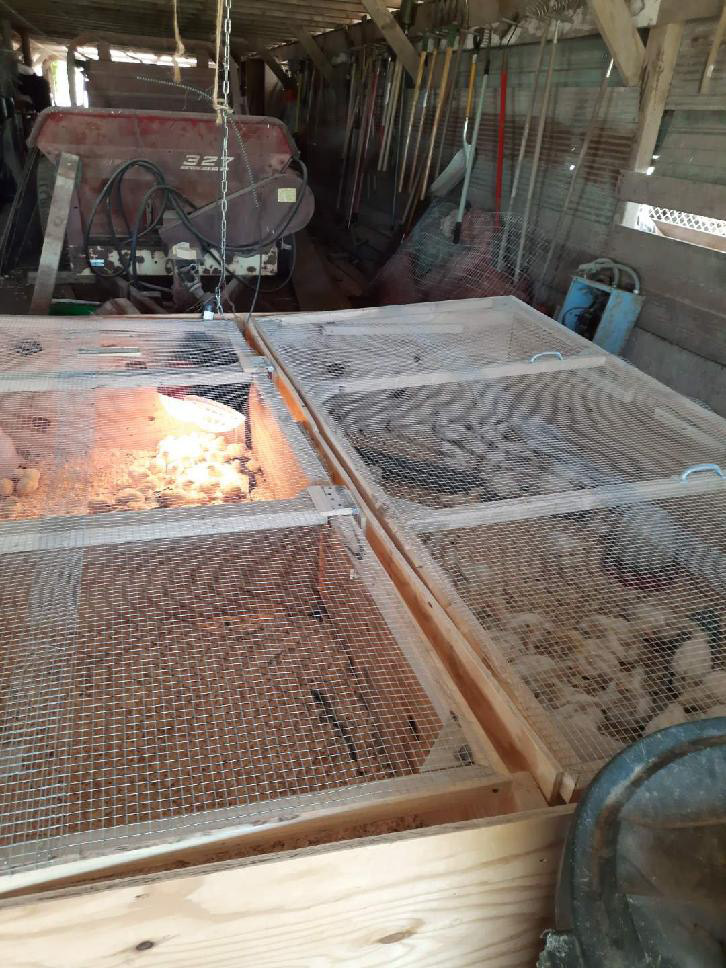
The broiler chickens were raised in brooders for 4 weeks (succession 1) or 5 weeks (succession 2) before being moved to the tractors on pasture in 2021.
Results and Discussion
In succession 1, five of the original 30 chickens from the control group were lost to mortality resulting in only 25 chickens slaughtered; all 30 chickens in the whey group survived to the end of the trial. In succession 2, both groups lost one chicken to mortality; they both finished with 28 chickens each.
Carcass weights of the control group were statistically greater than the carcass weights of the whey group in succession 1 (Figure 1). On average, chicken carcasses from the control group out-weighed those from the whey group by 11.6 oz. In succession 2, carcass weights of the two groups were statistically equal (Figure 1). Across the two groups of chickens, average carcass weight was 67.4 oz in succession 2. The greater carcass weights from succession 2 compared to succession 1 are likely due to larger starting weights and because twice as much feed was offered to chickens in succession 2 (Table 1).
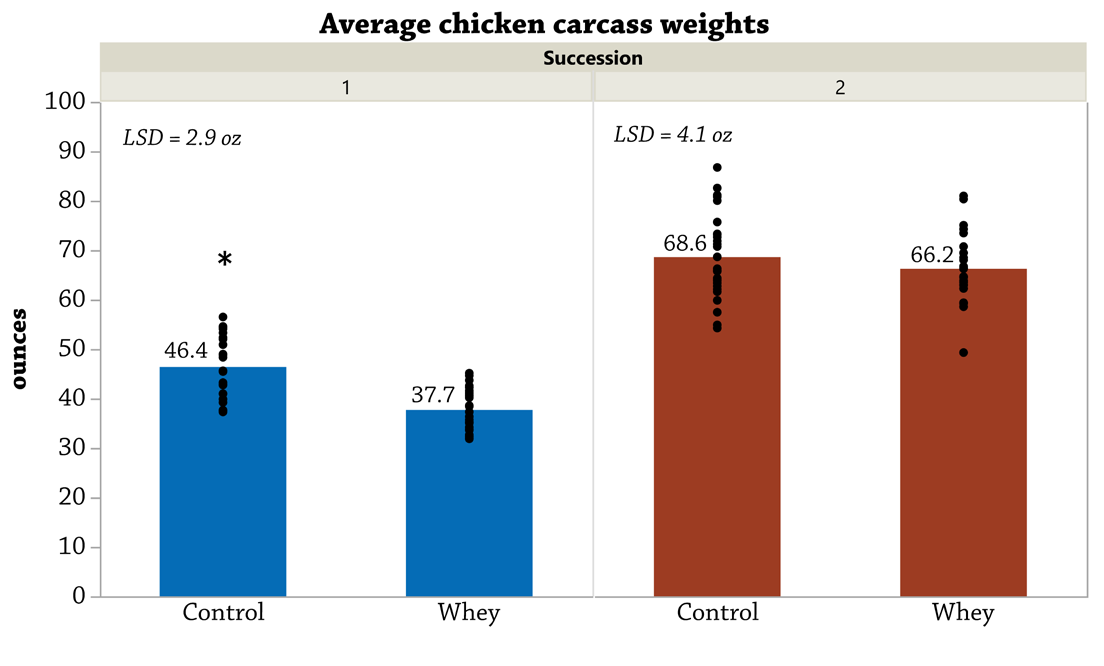
FIGURE 1. Average carcass weights of broiler chickens that were offered whey with feed compared to the control group that was not offered whey in 2021. Points represent individual carcass weights; bars and values represent the treatment averages. By succession, an asterisk (*) indicates a statistical difference at the 95% confidence level – the treatment averages differed by more than the LSD (least significant difference).
Conclusions and Next Steps
Before the onset of the trial, the cooperators hypothesized that compared to the control group, chickens offered whey with their feed would result in a larger carcass weight. After two successions of the trial, we did not see any improvement in carcass weight from offering whey with feed. “Because the whey did not significantly increase production in our meat chickens, we will not continue feeding whey,” Maja Black said of their results and next steps. Though they did not find an outlet in their broiler chickens for the whey they produce on farm, the cooperators found the trial extremely helpful because raising broiler chickens is a new enterprise for the farm. “The trial helped us pay close attention and keep better records, both of which helped us draw more conclusions about our chicken raising process in general, and how to make it work for us!” Maja Black said. “We did learn a lot about chicken diet and how chickens fit into our farm system. We have a lot of follow-up questions about finishing broilers with different types of feed and grazing strategies!”
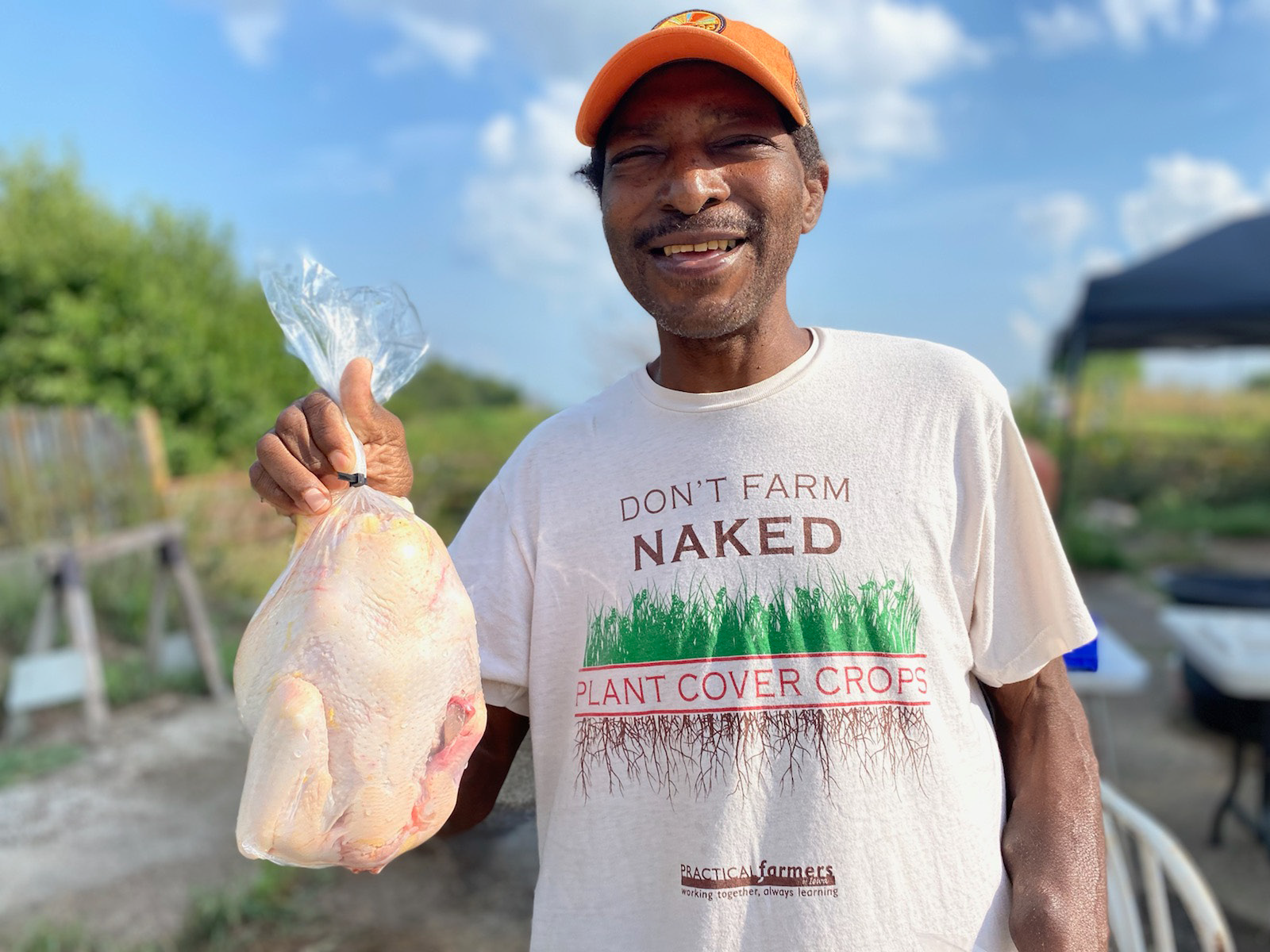
Carlos Williams proudly displays the final product after broiler chickens were raised on pasture in 2021.
References
- Esmail, S. 2016. Understanding protein requirements. Poultry World. https://www.poultryworld.net/Nutrition/Articles/2016/11/Understanding-protein-requirements-2914798W/ (accessed September 2021).
- Hermes, J. 2014. Feeding Meat-type Chickens. Pacific Northwest Extension. Oregon State University; University of Idaho; Washington State University. https://catalog.extension.oregonstate.edu/sites/catalog/files/project/pdf/pnw658.pdf (accessed September 2021).
- Coffin, D. 2020. Nutrition for Backyard Chicken Flocks in Maine. University of Maine Cooperatrive Extension. https://extension.umaine.edu/publications/2222e/ (accessed September 2021).


